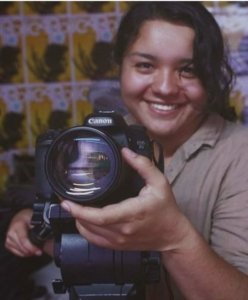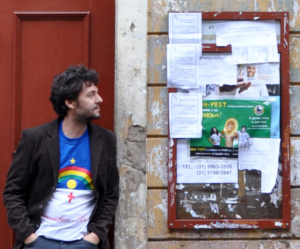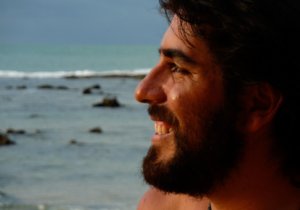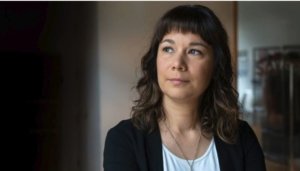October 15 @ 8:15 PM
Cole Cinema, Campus Center
St. Mary’s College was proud to screen the following films during the 11th Annual TFMS Film Series’ program of short films. The program lasted approximately 1.5 hours. Afterwards, Anishinaabe filmmaker Lisa Jackson led a post-screening Q & A.
Films by Amanda Strong
Amanda Strong is an Indigenous (Michif) filmmaker, media artist, and stop-motion artist currently based out of the unceded Coast Salish territory also known as Vancouver. Strong’s work explores ideas of blood memory and Indigenous ideology. In 2010 she founded Spotted Fawn Productions (SFP), whose mission is to provide mentorship and training opportunities for emerging and diverse artists. SFP achieves this by creating space for Indigenous people, women and non-binary individuals to engage in the many aspects of film, animation, and production, a community-oriented studio with a focus on illustration, stop motion, 2D, 3D, and virtual reality animations. Together collaborators create innovative, layered digital projects with compelling characters, art, and stories. Through acts of reclamation and collaboration, they tell their own stories, in their own voice, lifting up and empowering the future of Indigenous storytelling in film.
_________________________
Indigo
directed by Amanda Strong (Michif)
Canada • 10 min • 2014 • Stop-motion animation
Indigo is a stop-motion animation that explores themes of imagination and the inner child via dolls and miniatures. The piece reflects Indigenous principles of the medicine wheel, stories of Grandmother Spider, and the director’s personal experiences. Teachings are embedded within the worlds in which Indigo, a confined woman, is liberated by Grandmother Spider while opaque memories restore her spirit as life nears its end.
__________________________
Mia’
directed by Amanda Strong (Michif) and Bracken Hanuse Corlett
Canada | 8 min | 2015 | Stop-motion animation
A young Indigenous female street artist named Mia’ walks through the city streets painting scenes rooted in the supernatural history of her people. Lacking cultural resources and familial connection within the city, she paints these images from intuition and blood memory. She has not heard the stories from her Elders’ lips but has found her own methods to re-discover them. The alleyways become her sanctuary and secret gallery, and her art comes to life. Mia’ is pulled into her own transformation via the vessel of a salmon. In the struggle to return home, she traverses polluted waters and skies. In her journey, she witnesses various forms of industrial violence that have imprinted upon the land.
Indigenous people in Canada experienced displacement once commercial trade turned into settlement. Today the urban population of Native people now outnumbers those living on-reserve. Many struggle since they are disconnected from their land and rites. This film is not an adaptation or a re-telling of a traditional story but is based in the circular time and passage of oral history. In challenging the notions and format of conventional documentaries, directors Amanda Strong and Bracken Hanuse Corlett present Indigenous oral traditions as truth, not myth or legend. Mia’ premiered at the Toronto International Film Festival (TIFF) in 2015.
__________________________
Flood
directed by Amanda Strong (Michif) and Bracken Hanuse Corlett
Canada | 4 min | 2017 | Digital and Stop-motion animation, shadow puppetry
Two characters, Spider Woman and Thunderbird, act as vessels, composing and carrying the story of an Indigenous youth named Thunder, who navigates her way through a colonial flood. Spider Woman battles against an old Ghost Judge who frenetically writes history from the side of oppression and displacement. The Ghost Judge fills the entire world with his writings and law. We are left wondering, who’s truth is real? What tactics do we use to decolonize, fight back, and move forward?
Films by Teresa Jiménez
Teresa Jiménez is a director, photographer, and graphic designer based in Guatemala City. She is the founder and director of Hacer Cine en Guatemala, a news site dedicated to creating space and increasing interest in Guatemalan film production. She is a member of the Guatemalan Association of Audiovisual and Cinematography (AGAcine) and a member of the Guatemalan women’s filmmaking collective, Colectivo Lemow.
_________________________
Kat Waj (Te quiero)
directed by Teresa Jiménez (Ladino)
produced by Verónica Sacalxot (Maya – Q’iche’)
Guatemala | 18:35 min | 2017 | Short drama
Ixmucané is a 12-year-old girl whose fascination with life and for reading is enormous. Although she lives in a family with few resources, she has the possibility of going to school, despite her father’s rejection of that prospect. Her life changes unexpectedly when her father makes a decision that sparks her to rebel against the destiny he wishes to impose.
Language: Maya, with English subtitles
Films by Charles Bicalho
Director, writer, editor, cinematographer, and producer, Charles Antonio de Paula Bicalho holds a PhD in Brazilian literature from the Universidade Federal de Mina Gerais. Founding member and coordinator of Pajé Filmes, an Indigenous audiovisual collective, Bicalho is general organizer and curator of the Pajé Indigenous Film Show in Belo Horizonte, Mina Gerais. He has directed the short films Caligrafilmes (2008), Making of Dictionary (2012), Pirapora (2012) and Konãgxeka: The Maxakali Flood (2016). His film work focuses mainly on the Indigenous peoples of Minas Gerais, his scholarship on semiotics, literature, cinema and new media, and design and communication.
_________________________
Konãgxeka: ou dilúvio Maxakali (Konãgxeka: The Maxakali Flood)
directed by Charles Bicalho and Isael Maxakali
Brazil | 13 min | 2016 | Short drama
“Konãgxeka” in the Maxakali Indigenous language means “big water,” whose equivalent in the West is the Great Flood. In the film, as punishment for men’s selfishness and greed, the yãmîy spirits send the “big water.” The illustrations were made by Indigenous Maxakali during workshops held at Aldeia Verde (Maxakali Green Village).
Language: Maxakali, with English subtitles
Films by Edgar Sajcabún
Edgar Noe Sajcabún Mux holds a script specialty from the film school of San Antonio de los Baños, Cuba. Sajcabún Mux wrote the screenplay for the Guatemalan film, The Greatest House in the World, which screened at the Berlin Film Festival, 2015. He also directed the short film Xik Vuh, which received the Icaro Award for Best Central American Short Film, 2014. In 2015, Sacjabun Mux was the recipient of the “Relève ‘Jeune espoir’” award, Montréal, Québec, Canada, for his promise as a young filmmaker.
________________________
El Camino es Largo (The Way is Long)
directed by Edgar Sajcabún
Guatemala (Maya Kaqchikel Nation) | 13 min | 2016 | Short fiction
A playful little Mayan boy walks a long way to his school through the mountains, where he is continuously distracted by the wonders of surrounding nature, especially by a fish. In this film, director Edgar Sajcabún uses the road as a metaphor for the distance that separates indigenous cultures from contemporary ones.
Language: Maya Kaqchikel, with English subtitles
Films by Juan Manuel Costa
Juan Manuel Costa holds a degree in film and television. For most of his career, he has specialized in cinematography (director of photography) for both fiction and documentary film. As an undergraduate, he studied animation, where he discovered a magical world rich in narrative, expressive, and aesthetic resources. Since earning his degree, he continues to research and experiment in stop-motion animation. In 2008, he opened his own animation studio, El Birque Animaciones (elbirque.com), located in the province of Córdoba, Spain. There, together with a team of filmmakers, artists, crafts people, musicians, and cartoonists, he generates projects for film and television.
_________________________
Doña Ubenza
directed by Juan Manuel Costa
Argentina | 4 min | 2015 | Stop-motion animation
A shepherdess leads her sheep to the top of a mountain in search of a special moment.
Films by Caroline Monnet
Caroline Monnet is a multidisciplinary artist from Outaouais, Québec. She studied in both sociology and communication at the University of Ottawa (Canada) and the University of Granada (Spain) before pursuing a career in visual arts and films. She is based in Montréal. Monnet is an alumnus of the Berlinale Talents and the TIFF Talent Lab 2016. Her award-winning work has appeared in exhibitions and festivals internationally, including the Palais de Tokyo (Paris) and Haus der Kulturen der Welt (Berlin) as part of the Rencontres Internationales, TIFF (CA), Sundance (US), Aesthetica (UK), Museum of Contemporary Art (Montréal), Arsenal Contemporary Art (Montreal), among others. Monnet is currently working on numerous projects, including the development of her first feature film, selected for the Cinéfondation residency in Paris, and a solo exhibition for the Walter Phillips Gallery at the Banff Centre for the Arts.
_________________________
Ikwé
directed by Caroline Monnet (Algonquin)
Canada | 4:45 min | 2009 | Experimental, single-channel video
An experimental film that weaves the intimate thoughts of one woman (Ikwé) with the teachings of her grandmother, the Moon, Ikwé creates a surreal narrative experience that communicates the power of thought and personal reflection.
Language: French and Cree, with English subtitles
_____________________________
Mobilize
directed by Caroline Monnet (Algonquin)
Canada | 3 min | 2015 | Experimental
In Mobilize, Monnet splices and transfigures segments of films taken from the National Film Board of Canada’s archive, such as César’s Bark Canoe (1971), Cree Hunters of Mistassini (1974), and High Steel (1965), shifting the perspective from white marvel to collective affirmation. The video weaves through scenes of labor in industrial and so-called natural settings, from snow-shoe building to the construction of New York’s cityscape. In both landscapes, Indigenous subjects are posited as builders, people who are in sync with their environment and navigate their surroundings with ease.
Giving equal weight to what has traditionally been thought of as craft and industry, Mobilize underscores how labor’s integrity is relative to who benefits from its exertion. These images inherently call into question how other classes have accumulated wealth through projects once belonging to Indigenous communities, while enforcing these communities’ demands of self-governance. Tanya Tagaq’s song “Uja” serves as the soundscape for Mobilize, with the acclaimed Inuk throat singer’s breath functioning as a rhythmic pulse to fervent scenes. As the title encourages, Mobilize is a call to action— a communal forward thrust unyielding to Colonialist notions of progress.
Description courtesy of Arsenal Contemporary Art
____________________________
Creatura Dada
directed by Caroline Monnet (Algonquin)
Canada | 4 min | 2016 | Experimental
Six powerful native women gather to celebrate a new beginning and the end of the world as we know it.
Films by Lisa Jackson
Suckerfish
directed by Lisa Jackson (Anishinaabe)
Canada | 8 min | 2004 | Cut-out animation, live-action
When she was ten, director Lisa Jackson fled Toronto to live with relatives in Vancouver to escape her mother’s depression, alcoholism, and prescription drug abuse – legacies of the residential school experience. Now, sifting through her memories and her mother’s letters, she constructs a portrait of a mother whose drive to love her daughter triumphed over her demons of addiction. Animation, childhood photographs, and stylized recreations add the young child’s whimsical voice to this moving, at times humorous, look at the director’s relationship to her mother and native identity.
_________________________
Savage
directed by Lisa Jackson (Anishinaabe)
Canada | 6 min | 2009 | Experimental, musical
On a summer day in the 1950s, a native girl watches the countryside go by from the backseat of a car. A woman at her kitchen table sings a lullaby in her Cree language. When the girl arrives at her destination, she undergoes a transformation that will turn the woman’s gentle voice into a howl of anger and pain. In a place like this, there aren’t many chances to be a kid. But, when no one’s watching . . .
Language: Cree, with English subtitles
Commissioned as part of the imagineNATIVE Film Festival’s Embargo Collective
__________________________
Snare
directed by Lisa Jackson (Anishinaabe)
Canada | 3:30 min | 2013 | Experimental
Spare and visually arresting, with a haunting soundtrack, Snare is a performance-based piece that captures the brutality of violence against aboriginal women, as well as the possibility of healing and grace.
Canada has been condemned by Amnesty International for the high level of violence against native women, and there has been an inquiry into the murdered and missing women in British Columbia. Most recently, the UN called for an investigation into the violence against Indigenous women in Canada. Snare is an artistic response to this real-life issue, bringing the experience of women to the forefront, as well as the possibility of healing, grace, and greater understanding.
